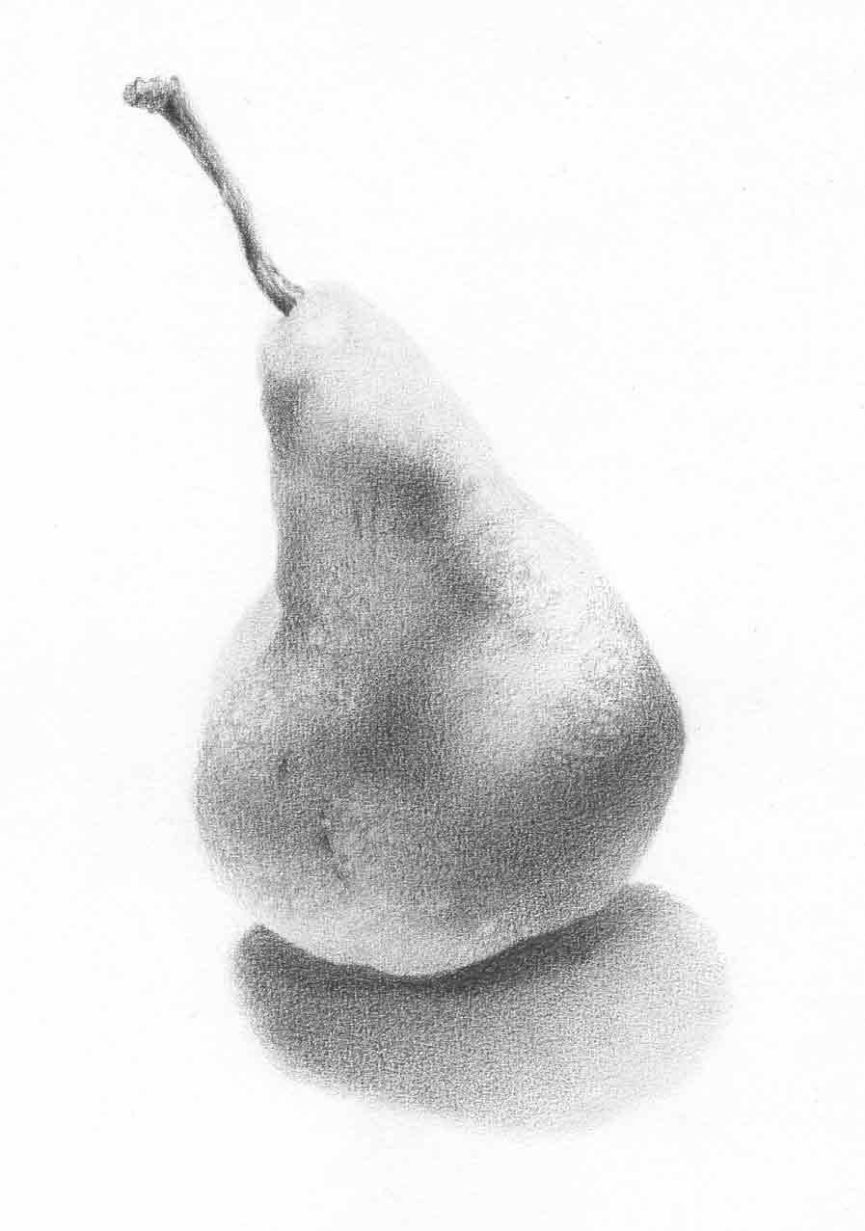I’ve just finished drawing a pear to demonstrate the classical drawing style and as I drew near the end of the drawing, the thought ‘how do I know when I’m finished?’ came into my mind.
I hear this question many times and of course have wondered about it myself. After years of ‘finishing’ paintings and drawings and never really knowing the answer, I’ve come up with the notion that your painting or drawing is finished, when you’re ready to let it go. The whole thing is subjective! Everyone is going to have a different idea about when something is finished. The conundrum doesn’t only apply to art, it applies to many things we undertake; when do I finish writing a book, creating a garden, making a video, cleaning the house??!
I worked as an illustrator for several years, both in the workplace and freelance. The catch phrase among people in the business (and we were also told this at Design School) was that 75% of what you would really like, is good enough i.e. it’s finished when you’ve spent enough time on it, when you’ve done your best and when most of the world would think it was finished.
As a portrait artist I keep working on the painting till I have the best likeness I can get (without going completely bananas) and till technically and compositionally I think it’s working well enough. It’s finished when I’m ready to let it go; when I think it’s good enough. I look back on some of my work and wouldn’t want to change a thing.
Other pieces I think “I could have done that bit differently…”, in other words, had I had more time, or the inclination (quite often, we don’t see those little things we could have done differently till we have been away from the work for a while) I might have stayed with it a little longer before letting it go.
I teach the strategies that help me ‘finish’ drawings and paintings to my students, because not knowing how or when to finish can feel like a stumbling block. I’ve realised over my years as an artist and art coach, that it is a combination of left and right hemispheric processing that supports us to pull the piece of art together, to create the ‘finished’ look we want. When we talk about finishing an artwork there are a number of factors at play, including technique, the visual aesthetic (style), and composition, which includes the relationships between shapes, tones, edges and colours. In my view when any one of these are out of balance in some way, the work (whether abstract or realistic) will feel unfinished.
You can process left hemispheric thoughts consciously – “that perspective is inaccurate, I know I can improve it by adjusting this angle.” Your right hemisphere processes unconsciously however and is more subtle. It is chock full of visual information you may not know you know and often presents as a question – “Does that green need to be darker?” or a hunch, “I think I might soften that edge.”
Sometimes it presents as a feeling of discomfort or unease in the body i.e. you may be looking at a landscape painting where the bridge has inaccurate perspective. You may not know why you’re uncomfortable but your right hemisphere has spotted the visual discrepancy. If you are the artist who has painted the offending bridge and you don’t know how to fix it, you can feel down right cross! Most visual annoyances and discrepancies can be resolved. 🙂
I have experienced the right hemispheric voice as a gentle question, as a silent state of flow, where I’m not aware of anything other than moving from one shape to another and as a really non negotiable command!
The two hemispheres not only have different voices but they see differently as well. In my experience the left is useful for spotting obvious inaccuracies – “That arm is way too long.” Its eye tends to either scan for information in a linear way or focus on one thing. The right, again more subtle, has a global eye; it is aware of the entire visual field, using what we know as ‘peripheral’ vision. It sees the parts, the relationships between the parts and the whole thing all at once.
Imagine you are walking in the bush; you gaze ahead of you, generally at the ground so you know where to put your foot, but you have an awareness of everything, so that if you go too close to the edge of a cliff or a stream, your right hemisphere will spot it and unconsciously you will move out of harms way. If you need to make an evaluation about how to navigate a fallen log, your left hemisphere is probably doing most of the processing. It is the global eye that I find very useful for sorting out the abstract shapes when finishing a piece of art.
It’s my view that the left hemisphere manages our capacity to finish things in a linear way – it set goals to achieve results and points out discrepancies to do with meaning (that drawing of a horse is good, it looks like a real horse/dumb horse; its head is way too big!) This helps when you want to finish a painting or drawing. The right manages our capacity to create visual completions. It processes the whole thing and knows when it is complete i.e. when nothing needs to be added or taken away; when there is harmony, ease or visual dynamism. This is also extremely helpful.
Over time I have learned to recognise the very different voice and eye of my two hemispheres and I believe we require and can consciously draw on both to help us complete whatever it is we need to finish, not only in art but in all areas of life.
|

